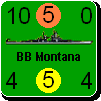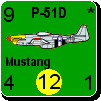Froonp
Posts: 7995
Joined: 10/21/2003
From: Marseilles, France
Status: offline

|
quote:
ORIGINAL: sajbalk
the map of America need not be overly studied, but the rule of thumb for cities of 100,000 could be uniformly applied. This is perhaps more useful for AiF, nonetheless, check;
http://www.census.gov/population/documentation/twps0027/tab18.txt
for for the 1940 census figures, at least the top 100 cities.
Thanks for the link  . .
About the "rule of thumb for cities of 100,000", it is not meant to add all cities with 100,000 inhabitants or more, on the map. Otherwise, there would be cities in all hexes in eastern China  . .
We need to stay faithfull with the WiF FE maps.
I think that it is ok for example to add cities in place where on the WiF FE maps units in their home country are in supply, and where in MWiF (due to exploding the scale) units are no more in supply.
For example, I considered adding cities between Spokane & Minneapolis (25 hexes distant), but I saw that on the WiF FE maps (AiF map) both places are distant by 22 European hexes, so the "no supply" zone in between themis normal, so I thought that no cities should be added there. By the way, Spokane is not on the WiF FE maps, it was added on the MWiF map by the origial CWiF designers.
quote:
Finally, it seems like a lot of hexes from Omaha to Kansas City.
About this, I noticed this too, and corrected it by moving Kansas City (and its rail to Wichita and the resource) 2 hexes E / NE. Omaha / Wichita / Little Rock should be aligned, and they are now.
< Message edited by Froonp -- 9/18/2006 11:20:45 PM >
|
 Printable Version
Printable Version



















 ) is already on the AiF (American in Flames) maps (that are used in normal WiF FE 39-45 campaigns).
) is already on the AiF (American in Flames) maps (that are used in normal WiF FE 39-45 campaigns). 




 New Messages
New Messages No New Messages
No New Messages Hot Topic w/ New Messages
Hot Topic w/ New Messages Hot Topic w/o New Messages
Hot Topic w/o New Messages Locked w/ New Messages
Locked w/ New Messages Locked w/o New Messages
Locked w/o New Messages Post New Thread
Post New Thread